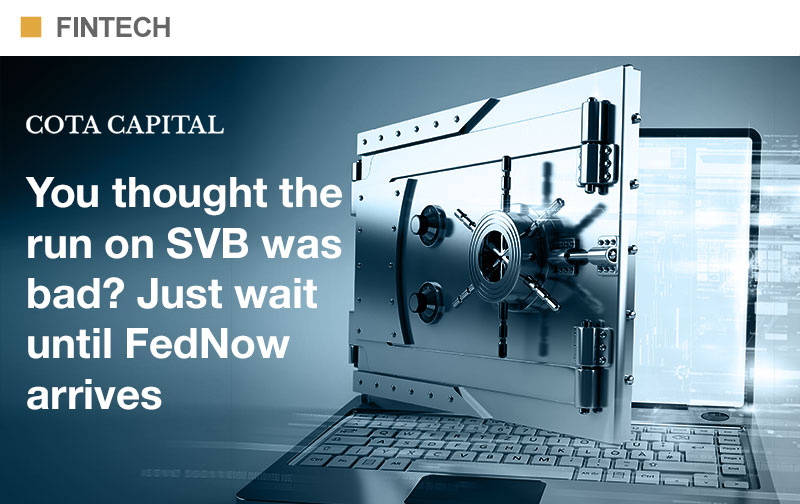
By Kevin Jacques and Ben Malka, Partners, Cota Capital
Published on Apr 20, 2023 in American Banker
The collapse of Silicon Valley Bank was the first real demonstration of a bank run in the digital age. Twitter- and WhatsApp-fueled panic pushed countless CEOs into a frenzy to withdraw funds from SVB as fast as they could. While news updates on SVB were instantaneous, withdrawal of funds, which still relies largely on wire transfers, was not. Many CEOs went to bed not knowing whether their wires went through, or if they’d be able to make payroll the next week. All told, depositors attempted to withdraw nearly all of the bank’s deposits over two days, and were able to extract $142 billion.
In the background, the delay in wire execution bought SVB and policymakers some (though limited) time to address the rapidly devolving situation, work to manage the contagion and search for emergency liquidity. In the future, thanks to real-time payments, they may not have as much time to react. A crisis could quickly spread to other banks, especially regional banks. With the Fed’s launch of its real-time payments system, FedNow, in July and the continued rapid growth of The Clearing House’s RTP platform, the U.S. is inching toward broad adoption of a real-time payments ecosystem.
Banks and regulators will have an even more challenging time addressing bank runs in an economy driven by instant payments. They must establish guardrails to ensure that real-time payments do not foster future banking crises by enabling swifter and more consequential runs on banks.
This is not an indictment of real-time payments — they provide immense benefits to the U.S. economy. Businesses that utilize real-time payments will have a more cost-effective and efficient payment system than wires or checks and far greater liquidity management. Consumers will have immediate access to their money, 24 hours a day, seven days a week, helping many prevent late fees and overdrafts by using instant bill pay. Consumers and merchants are clearly looking for a more efficient, secure and accessible payments option. Real-time payments will provide this.
Treasury Secretary Janet Yellen has already said that the government may take steps to prevent future bank runs, especially at smaller and medium-size banks. As part of her toolkit, she must work alongside the Fed and The Clearing House to establish guidance for real-time payments systems that will benefit the economy and not jeopardize the health of the banking system.
The most obvious first requirement centers around velocity limits. As of now, depository institutions on The Clearing House’s RTP network must accept payments up to $1 million, though participants may set a lower limit for payments that they originate. For FedNow, the transfer limit is $500,000, though participants have a default limit of $100,000. Under an SVB-like scenario in which numerous companies seek to withdraw assets from one financial institution, real-time payments, with high transaction limits and more rapid execution than traditional wires, could trigger an immediate and harder-to-contain crisis.
Financial institutions will have to ensure that their velocity limits reduce the potential for rapid, massive deposit outflows and that these limits can be quickly adjusted in the case of a major scare. While velocity limits may hinder the utility and benefits of real-time payments in a small percentage of transactions, given the fragility of the banking system, policymakers would serve their financial institution constituents well by following these steps: recommending velocity limits, providing economic intelligence and alert services for real-time payment providers on potential bank-run inducing events, and ensuring responsive support for financial institutions seeking to alter their velocity limits.
We also advise financial institutions, both big banks and regional players, to get on the same page on such limits to ensure there is not a “race to the top” in which banks provide higher transaction limits to outcompete other banks. Market forces ought not to incentivize banks to create new risks through their real-time payment transaction limits during precarious economic times.
Financial institutions should also take incremental steps in adopting real-time payments. This could include first accepting real-time payment deposits from customers, followed by withdrawals thereafter. This would enable banks to better understand real-time payments operationally before supporting instantaneous customer withdrawals. At the same time, banks must implement robust verification and authentication processes for every transaction to prevent fraud and abuse, including account takeover attacks. These measures could include out-of-band verification for large transfers.
Real-time payments will pose new opportunities and challenges. As the entire financial sector navigates a turbulent time, decision-makers must ensure that we do not sacrifice stability for speed, while also keeping an eye focused on future payments innovation.
